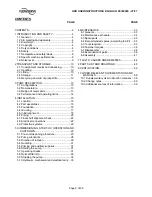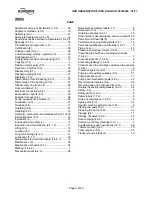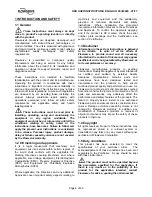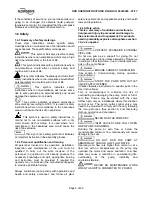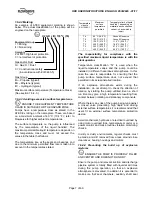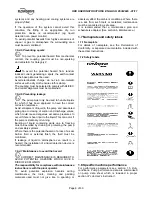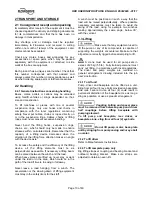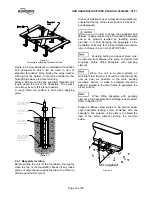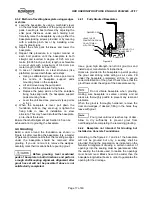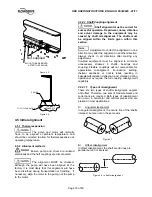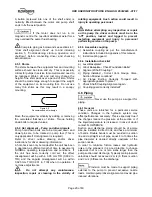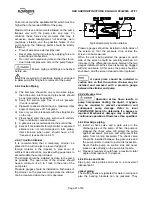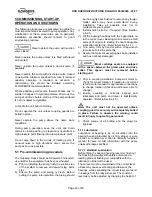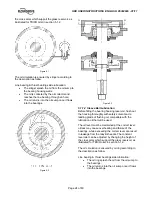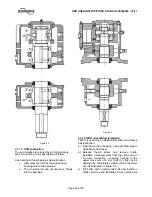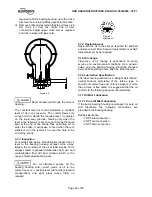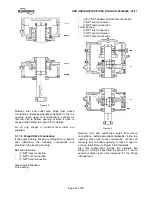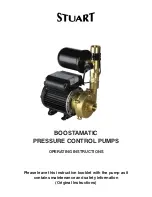
HDX USER INSTRUCTIONS ENGLISH 85392696 - 01/11
Page 12 of 60
Each inspection should consist of a general surface
inspection to assure that:
a) Pump supports are firmly in place.
b) Pump covers over openings are firmly in place.
c) Pump coverings, plastic or tarps are firmly in
place. Any holes or tears must be repaired to
prevent entrance of dirt or water.
d) Pump covers are periodically removed from
openings and interior accessible areas inspected.
If surface rusting has occurred, clean or coat with
preservative.
e) If rusting occurs on exterior surfaces clean and
repaint or coat with preservative.
f) Check individually wrapped parts for signs of
deterioration. If necessary, renew preservative
and wrapping.
Six months prior to the scheduled installation date, a
FLOWSERVE representative is to be employed to
conduct an inspection. This inspection may include,
not necessarily in its entirety and not limited to the
following:
a) An inspection of all periodic inspection records as
kept on file by the purchaser, and all inspection
reports that have been compiled during the
storage period.
b) An inspection of the storage area to determine
the "as stored" condition of the equipment prior to
any protection covers being removed.
c) An inspection of the equipment with protective
covers and flange covers removed.
d) Depending upon the length of time the equipment
was stored, the type of storage provided (i.e.
Indoor: heated, unheated, ground floor, concrete
floor. Outdoors: under roof, no roof, waterproof
coverings, on concrete, on ground) and as a
result of the inspection of (a),(b) & (c) above the
FLOWSERVE representative may require a
partial or complete dismantling of the equipment.
e) Dismantling may necessitate restoration of
painted or preserved surfaces, and, or
replacement of gaskets, "O" rings, packing and
bearings.
f) All costs involved during inspection, dismantling,
restoration, replacement of parts and reassembly
will have to the accounted to the purchaser. All
necessary labour, tools and cranes will be
supplied by the purchaser.
Upon completion of the inspection the FLOWSERVE
representative shall submit a report to the purchaser,
and to the Manager of Customer Service, stating in
detail the results of the inspection.
One month prior to installation of the equipment, a
FLOWSERVE representative is to be employed to
conduct a final inspection.
This inspection will be made to assure that the
requirements of the six months inspection report were
satisfactorily completed and that the equipment is
ready for installation.
Upon completion of this inspection the FLOWSERVE
representative shall submit a final report to the
purchaser, and to the Manager of Customer Service,
advising the results of the final inspection.
All costs involved in conducting the final inspection
will have to the accounted to the purchaser.
Prior to and during start up, any requirements for the
services of an FLOWSERVE representative will
revert back to the original contract agreement for
equipment purchased, with revised costing.
2.4.1.4 Painting and preservation
Paints and preservatives used are either
FLOWSERVE standard or 'special' as required by the
contract specification. Refer to FLOWSERVE for the
description of paints and preservatives used on this
order if needed.
2.4.1.5 Associated equipment
Motors, Turbines, Gears, etc., being supplied by
FLOWSERVE.
Generally rotors of associated equipment should be
blocked to relieve bearing loads. Storage should be
indoors and dry. See the specific manufacturers
storage requirements.
2.5 Recycling and end of product life
At the end of the service life of the product or its
parts, the relevant materials and parts should be
recycled or disposed of using an environmentally
acceptable method and local regulations. If the
product contains substances which are harmful to the
environment, these should be removed and disposed
of in accordance with current regulations. This also
includes the liquids and or gases in the "seal system"
or other utilities.
Make sure that hazardous substances or
toxic fluids are disposed of safely and that the correct
personal protective equipment is used. The safety
specifications must be in accordance with the current
regulations at all times.


